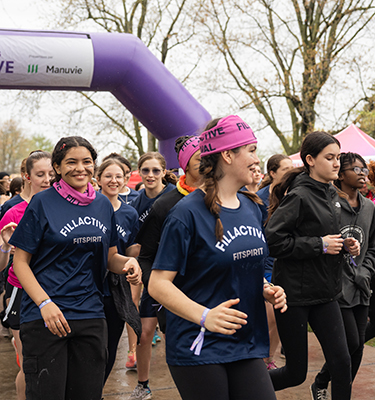Check-up check list: A guide to your next eye exam
August 26, 2025 | 5 min read
Most people think of optometrist appointments as a way to see if they need a new prescription for glasses or contacts. But eye exams can also help uncover other health issues before they become a problem, says Dr. David Redman, an optometrist and a Chief Strategy Officer and VP at FYidoctors, a Manulife eye care partner, with more than 300 doctor-owned and -led locations across Canada.
“Routine exams test your vision, but they also assess the overall health of your eyes, and the rest of your body, too,” says Redman. He points out that many otherwise invisible health conditions—such as eye strain, retinal detachment, eye cancers, diabetes, and hypertension—are often discovered during routine eye exams.
Because of this, Dr. Redman recommends you think of eye exams less as something you only bother with when your vision gets blurry, and more as a regular fixture in your health calendar—like a dental check-up.
Below are some topics that experts from FYidoctors say may be relevant to your next eye exam, and lead to productive discussions with your optometrist.
Overall eye health
- Expect your optometrist to sum up the overall health of your eyes—beyond your vision. “Many people think, ‘Oh, I see fine,” says Dr. Redman. “But there are problems that can’t be seen without an eye exam.”
- For yearly visits, in addition to going over what has changed since your last exam, it's helpful to discuss what might be causing those changes.
- Ask whether you’re demonstrating any eye issues that might be indicative of a broader health issue. For example, an eye exam can often reveal damaged blood vessels in the retina—an early indicator of dangerously high blood sugar.1 “Often, the first symptoms of conditions like diabetes show up in the eyes,” says Dr. Redman. Hypertension can also be caught early through an eye exam.
- Inquire about any additional procedures tied to preventive health that may be covered by your plan. For instance, wide field retinal imaging, also known as an optomap, can detect signs signs of diabetes, hypertension, and macular degeneration. “We recommend everyone do this,” Dr. Redman says.
- Ask about emerging treatments that might mitigate or improve your vision issues, such as corneal refractive therapy, which is a non-surgical method that can treat myopia (nearsightedness).
Keep Learning: Good question: Can I Stop my Vision from Getting Worse?
With eye disease on the rise in Canada, experts explain why the benefits of preventive eye health are becoming even more clear.

Eyewear
- If you’re experiencing eye strain, ask about blue-light or anti-reflective lens coatings.
- Your optometrist may suggest different lens prescriptions for different tasks, such as screen use or driving.
- Request information about new technologies. “There are so many innovations in eye care taking place today,” explains Braden Hoeppner, a Vancouver-based Vice President at FYidoctors. “Here’s one example: People with astigmatism or presbyopia were once discouraged from using contact lenses—now, that’s changed.”
Keep Learning: Check-up Checklist: What to ask your doctor in your 40s and 50s
Expert advice on how to take care of ‘future you’ and advocate for a healthier road ahead

Lifestyle changes that can protect eye health
- It’s often useful to talk about healthier habits that might reduce potential eye issues in the future. For instance, getting regular exercise, eating a diet rich in nutrients, and practicing good sleep hygiene can all help you avoid conditions associated with vision loss, such as diabetes and hypertension. And if you do a lot of work in front of a computer, scheduling periodic nature breaks—or even a quick walk down the street—can give your eyes a break.
- Speaking of screen time: It can accelerate vision issues like myopia and dry eyes.2 If you spend a lot of time working in front of a computer, ask what you can do to reduce or mitigate the effects of screens on your vision.
- Exposure to too much of the sun’s ultraviolet (UV) light can damage eyeball lenses,3 which can lead to eye issues like cataracts. Consider asking how to sufficiently protect your eyes against sun damage. (Dr. Redman points out that this is rarely a one-size-fits-all equation: For instance, people with less pigment in their eyes absorb damaging ultraviolet rays faster than those with darker coloured eyes.)
- If your eyes often feel dry or itchy, ask whether eye drops might be beneficial.
Keep Learning: 5 ways to turn physical activity for teens into a life-long habit
Experts from Quebec’s FitSpirit and Olympic champion Maude Charron share how to encourage physical activity and healthy habits in teenagers.

Children’s eye health
Human eyes develop rapidly in the first five years of life. Dr. Redman says early identification of issues can ward off potential vision problems before they interfere with learning and social development. He recommends babies get their first eye exam at six months, followed by quick check-ins at age one, three, and five. From school age and up, annual check-ups are advised.
- If you have a baby, toddler, or preschooler, it’s good to understand what’s ahead with their eye development more broadly.
- If your school-age child struggles with reading or experiences regular behavioural issues at daycare or school, ask whether their vision may be a contributing factor. “Kids can be diagnosed with ADHD and other conditions for issues that are really caused by eye problems,” says Dr. Redman.
- If you have a school-age kid or a teen, ask your optometrist to share age-appropriate advice about how they can better protect their vision.
- Consider raising your child’s screen habits and whether or not they are putting them at risk for myopia or other vision problems common among youth.
Being more aware of what’s involved in an eye exam can lead to more productive appointments, and help keep eyes healthier over time. “Many of us don’t think of eye health until we find ourselves squinting at our computers,” says Caitlin Heywood, AVP of Member Experience & Growth at Manulife. “But routine vision screenings are an important part of overall preventative health. Keeping on top of them can put you more in control of your eye health.”
Benefits check
Many group benefits plans include coverage for eye exams, prescriptions glasses, contacts and other vision-related claims. If you have vision coverage with Manulife, the Manulife Mobile app and plan member site both include coverage details, balances, and coverage limits to help you prepare for your next check-up.
This article is for informational purposes only. It is not intended to diagnose or treat a condition. If you have questions or concerns about your specific situation or are seeking medical advice, contact your medical doctor or your healthcare provider.
About FYihealth
FYihealth group is Canada’s largest optometric network with over 370 optometry clinics and retail stores across the country. Doctor-led, professionally managed, and patient-focused, our organization concentrates on delivering outstanding eye care with patient-centric products and services. Recognized as one of Canada's Best Managed Companies for five consecutive years, featured on the Globe and Mail’s Report on Business ranking of Canada’s Top Growing Companies for two consecutive years, as well as a certified Great Place to Work® in Canada and the USA. Our glasses are Made in Canada! We own and operate the largest Canadian lens manufacturing facility in Delta, British Columbia. FYihealth group is helping shape the future of Canadian eye care.